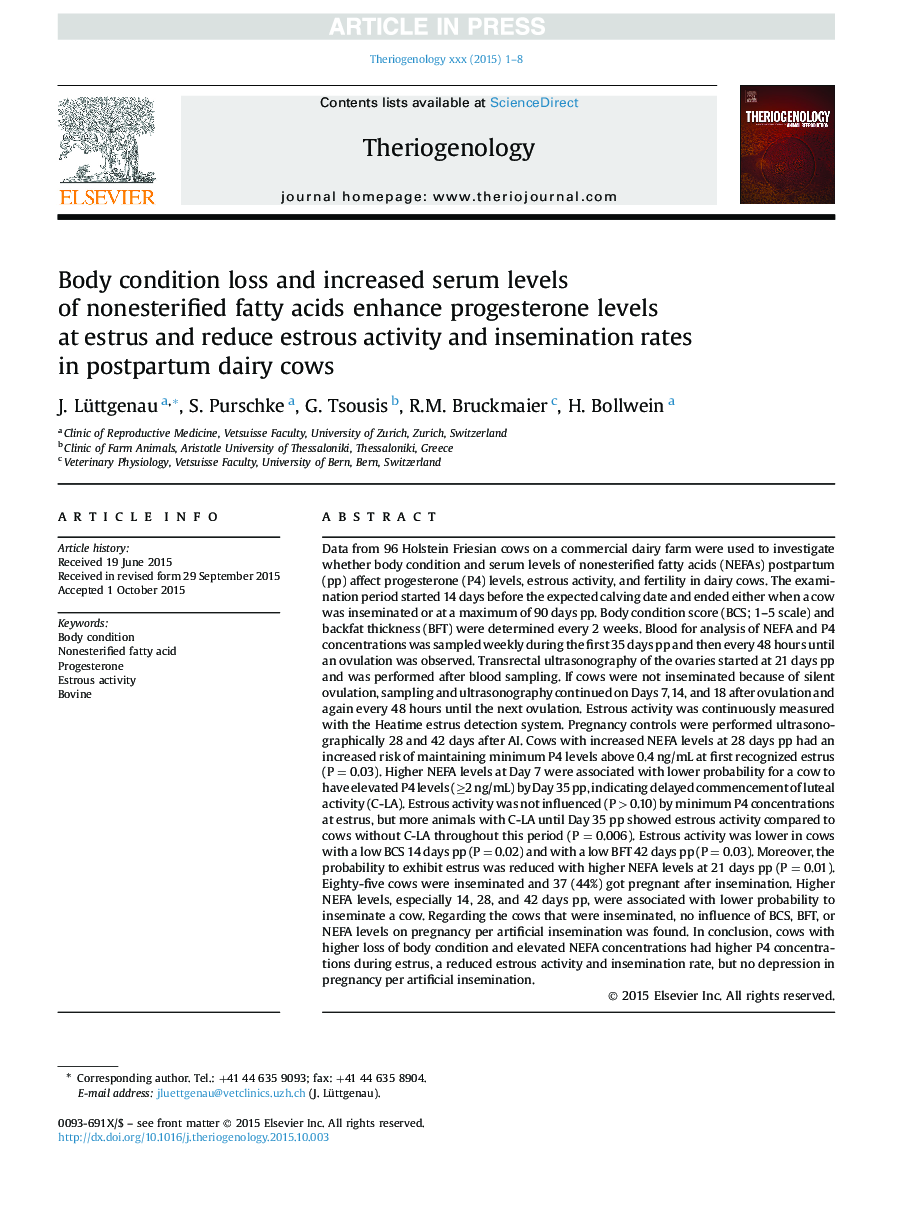| کد مقاله | کد نشریه | سال انتشار | مقاله انگلیسی | نسخه تمام متن |
|---|---|---|---|---|
| 10891713 | 1082060 | 2016 | 8 صفحه PDF | دانلود رایگان |
عنوان انگلیسی مقاله ISI
Body condition loss and increased serum levels of nonesterified fatty acids enhance progesterone levels at estrus and reduce estrous activity and insemination rates in postpartum dairy cows
ترجمه فارسی عنوان
از دست دادن وضعیت بدن و افزایش سطح سرمی اسیدهای چرب غیراستریدی باعث افزایش سطح پروژسترون در استراس و کاهش فعالیت استروی و میزان تلقیح در گاوهای شیرده پس از زایمان
دانلود مقاله + سفارش ترجمه
دانلود مقاله ISI انگلیسی
رایگان برای ایرانیان
کلمات کلیدی
وضعیت بدن، اسید چرب غنی شده پروژسترون، فعالیت عصبی، گاو،
موضوعات مرتبط
علوم زیستی و بیوفناوری
علوم کشاورزی و بیولوژیک
علوم دامی و جانورشناسی
چکیده انگلیسی
Data from 96 Holstein Friesian cows on a commercial dairy farm were used to investigate whether body condition and serum levels of nonesterified fatty acids (NEFAs) postpartum (pp) affect progesterone (P4) levels, estrous activity, and fertility in dairy cows. The examination period started 14 days before the expected calving date and ended either when a cow was inseminated or at a maximum of 90 days pp. Body condition score (BCS; 1-5 scale) and backfat thickness (BFT) were determined every 2 weeks. Blood for analysis of NEFA and P4 concentrations was sampled weekly during the first 35 days pp and then every 48 hours until an ovulation was observed. Transrectal ultrasonography of the ovaries started at 21 days pp and was performed after blood sampling. If cows were not inseminated because of silent ovulation, sampling and ultrasonography continued on Days 7, 14, and 18 after ovulation and again every 48 hours until the next ovulation. Estrous activity was continuously measured with the Heatime estrus detection system. Pregnancy controls were performed ultrasonographically 28 and 42 days after AI. Cows with increased NEFA levels at 28 days pp had an increased risk of maintaining minimum P4 levels above 0.4 ng/mL at first recognized estrus (P = 0.03). Higher NEFA levels at Day 7 were associated with lower probability for a cow to have elevated P4 levels (â¥2 ng/mL) by Day 35 pp, indicating delayed commencement of luteal activity (C-LA). Estrous activity was not influenced (P > 0.10) by minimum P4 concentrations at estrus, but more animals with C-LA until Day 35 pp showed estrous activity compared to cows without C-LA throughout this period (P = 0.006). Estrous activity was lower in cows with a low BCS 14 days pp (P = 0.02) and with a low BFT 42 days pp (P = 0.03). Moreover, the probability to exhibit estrus was reduced with higher NEFA levels at 21 days pp (P = 0.01). Eighty-five cows were inseminated and 37 (44%) got pregnant after insemination. Higher NEFA levels, especially 14, 28, and 42 days pp, were associated with lower probability to inseminate a cow. Regarding the cows that were inseminated, no influence of BCS, BFT, or NEFA levels on pregnancy per artificial insemination was found. In conclusion, cows with higher loss of body condition and elevated NEFA concentrations had higher P4 concentrations during estrus, a reduced estrous activity and insemination rate, but no depression in pregnancy per artificial insemination.
ناشر
Database: Elsevier - ScienceDirect (ساینس دایرکت)
Journal: Theriogenology - Volume 85, Issue 4, 1 March 2016, Pages 656-663
Journal: Theriogenology - Volume 85, Issue 4, 1 March 2016, Pages 656-663
نویسندگان
J. Lüttgenau, S. Purschke, G. Tsousis, R.M. Bruckmaier, H. Bollwein,
